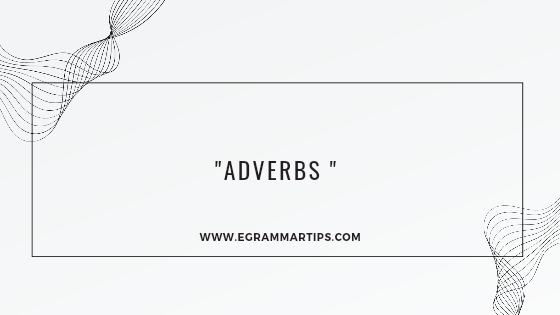
Table of Contents
Toggle1. Understanding Adverbs in Detail
Adverbs do much more than modify verbs; they modify adjectives, other adverbs, entire clauses, and sentences. They bring precision to English by answering how, when, where, how often, and to what degree an action happens.
Example:
- Modifying a verb: She sings beautifully.
- Modifying an adjective: He is extremely tired.
- Modifying an adverb: She finished surprisingly quickly.
2. Classification of Adverbs
Let’s go deeper into each adverb type with examples and nuances:
•Adverbs of Manner (How?)
Description: Describe how an action is performed.
Examples: bravely, gracefully, secretly
Placement Nuance: While typically placed after the verb or object (She danced gracefully), they can also appear at the beginning or end of sentences for emphasis (Gracefully, she danced all night).
•Adverbs of Time (When?)
Description: Indicate the time or duration of an action.
Examples: yesterday, immediately, soon
Placement Nuance: Generally appear at the end of sentences (I’ll see him tomorrow), but can also come at the start for emphasis (Yesterday, I met him).
•Adverbs of Place (Where?)
Description: Tell where an action occurs.Examples: here, nearby, everywhere
Placement Nuance: Usually appear after the verb or the verb’s object (She looked everywhere), though they may also start a sentence for style (Everywhere she looked, there were signs of spring).
•Adverbs of Frequency (How Often?)
Description: Express the regularity of an action.Examples: always, seldom, usually
Placement Nuance: Generally come before the main verb but after “to be” verbs (I always study / She is often late). If placed at the beginning or end, it changes emphasis (Often, she arrives late).
•Adverbs of Degree (To What Extent?)
Description: Show the intensity or level of an action or quality.Examples: barely, extremely, almost
Placement Nuance: They usually come before the word they modify (She was quite upset), but certain degree adverbs like enough come after (fast enough).
•Interrogative Adverbs (Used in Questions)
Examples: how, when, where, why
Used to form questions, often at the beginning (Why are you here?). These words also function as relative adverbs.
•Relative Adverbs
Description: Connect clauses, functioning like a conjunction and referring to time, place, or reason.Examples: when, where, why
Example in Sentence: This is the house where I grew up.
3. Forming Adverbs: Beyond the Basics
•Standard Formation with -ly:
Most adverbs are formed by adding -ly to adjectives (slow → slowly).
Exceptions: Adjectives ending in -ic change to -ically (tragic → tragically).
•Irregular Adverbs:
Some adverbs don’t follow the -ly rule:
Fast (same form for adjective and adverb).
Well (adverb form of good).
Note that these can sometimes affect meaning: hard vs. hardly.
4. Placement Nuances and Emphasis in Sentences
•Adverb Flexibility:
In English, adverbs can often move around a sentence, but the placement affects emphasis and meaning.
She quickly completed the work vs. She completed the work quickly (adds urgency).
•Middle Position:
Adverbs placed mid-sentence (especially after auxiliary verbs) often suggest regularity (She has always loved reading).
•Sentence Adverbs: Adverbs like frankly, clearly, honestly comment on the whole sentence and are often placed at the beginning.
Frankly, I don’t believe him.
5. Comparative and Superlative Adverbs
Forming Comparatives and Superlatives:
For shorter adverbs: add -er (comparative) and -est (superlative) (fast → faster → fastest).
For longer adverbs: use more and most (carefully → more carefully → most carefully).
Special Cases: Some adverbs are irregular:
well → better → best
badly → worse → worst
6. Advanced Usage and Common Mistakes
•Adjective vs. Adverb Misuse:
Misusing an adjective in place of an adverb is common in English, especially with verbs of perception (She looked quick vs. She looked quickly).
•Misplacing Frequency Adverbs:Place adverbs of frequency correctly to avoid confusion: I always study (correct) vs. I study always (incorrect).
•Avoiding Double Negatives:Some adverbs, such as never, already imply negation. Avoid using them with other negatives: I don’t need any help (correct) vs. I don’t need no help (incorrect).
7. Deep Practice with Complex Sentences
Combining Multiple Adverbs:
When combining multiple adverbs, the order is usually manner, place, and then time.
He sang beautifully at the concert last night.
Using Adverbs with Clause Integration:
Adverbs can integrate clauses smoothly. She left when the rain started (relative adverb as a conjunction).
Emphasis on Degree with Intensity:
For emphasis, adverbs like extremely, utterly, absolutely are used with strong adjectives.I am utterly convinced.
This depth of understanding equips you to use adverbs effectively and explore how subtle changes in adverb placement and choice can create nuanced, precise meanings in English.